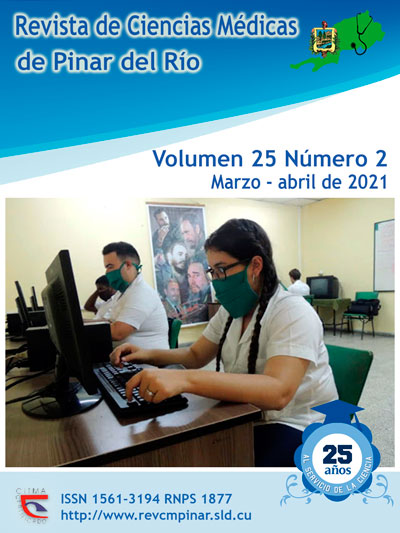Extension on the application of Heberprot-P to the diabetic foot in Pinar del Rio province
Keywords:
DIABETES MELLITUS, DIABETIC FOOT/therapy, AMPUTATION, PRIMARY HEALTH CARE, QUALITY OF LIFE.Abstract
Introduction: the fear to diabetic foot is a sequela of two chronic complications of diabetes mellitus, peripheral neuropathy and vascular insufficiency.
Objective: to assess the impact of the intra-lesion application of Heberprot-P to patients with diabetic-foot ulcers in Pinar de Rio province from January 2012 to May 2014.
Methods: an intervention, descriptive, retrospective and cross-sectional study was carried out in patients with diabetic-foot ulcers treated with Heberprot-P in the period 2012-2014. The target group comprised 2 225 diabetic patients and a sample of 2 060 with diabetic foot, using the descriptive statistics by means of absolute frequencies and relative percentages.
Results: type-2 diabetes mellitus prevailed (88 %), having 20 health facilities for the treatment, mainly outpatient clinics, 75 % of the consultations were possible due to increased employment in Primary Health Care and generally for years, neuroinfectious diabetic foot (88 %) and Wagner’s 2 (64 %) predominated; it was necessary to perform major amputation for 0,9 % of the cases.
Conclusions: the extension on the application of Heberprot-P to diabetic foot is beneficial thanks to the multiple health facilities involved in this task along with the training of doctors of medicine, nursing care personnel and podiatrists, making possible the increase of ambulatory care in Primary Health Care and the early diagnosis of the lesions, decreasing at the same time, the costs of the hospital stays, reaching the service to those who needed it, with 99,0 % of effectiveness and a low percentage of amputation, improving the quality of life.
Downloads
References
1. La diabetes, un gran problema sanitario. Universidad de Burgos [Internet]. 2017 [citado 07/12/2020]. Disponible en: https://www.ubu.es/noticias/la-diabetes-un-gran-problema-sanitario
2. Silva Pupo M, González Moya IA, Valenciano García Y, González Cedeño M. Evolución de lesiones complejas en el pie diabético con uso de Heberprot-P®. AMC [Internet]. 2019 [citado 07/12/2020]; 19(4): 357-65. Disponible en:
http://scielo.sld.cu/scielo.php?script=sci_arttext&pid=S1025-02552015000400007&lng=es
3. Whiting DR, Guariguata L, Weil C, Shaw J. IDF Diabetes atlas: global estimates of the prevalence of diabetes for 2017 and 2030. Diabetes Research Clinical Practice [Internet]. 2017 [citado 07/12/2020]; 94(3): 311-21. Disponible en: https://www.sciencedirect.com/science/article/abs/pii/S0168822711005912
4. Llanes Barrios JA, Acosta Ravelo Y, Martínez Díaz Y, Melgarejo Rivero B, Torres Zaldivar A. Atención multidisciplinaria con terapia avanzada y de recurso a pacientes con pie diabético en Mayabeque. Rev Cubana Angiol Cir Vasc [Internet]. 2015 [citado 07/12/2020]; 16(2): 139-53. Disponible en:
http://scielo.sld.cu/scielo.php?script=sci_arttext&pid=S1682-00372015000200003&lng=es
5. Li Y, Burrows NR, Gregg EW, Albright A, Geiss LS. Declining rates of hospitalization for nontraumatic lower-extremity amputation in the diabetic population aged 40 years or older: U.S., 2008–2018. Diabetes Care [Internet]. 2012 Feb [citado 07/12/2020]; 35(2): 273–7. Disponible en: https://www.ncbi.nlm.nih.gov/pmc/articles/PMC3263875/
6. Fernández Montequín J, Herrera Martínez LS, Negrín Martínez S, Berlan Acosta J, López Mola E, Valdés Pavón RA, et al. Manual de promotores Heberprot-P. Una herramienta imprescindible para los heberpropistas. La Habana: Editorial Elfos Scientiae; 2017.
7. García Herrera AL. Diagnóstico y tratamiento del pie diabético. La Habana: Editorial Elfos Scientiae; 2018.
8. Uso del Heberprot- P reduce en 71% amputaciones a cubanos con ulceras del pie diabético. Revista Bohemia [Internet]. 2019 [citado 07/12/2020] Disponible en: http://bohemia.cu/salud/2019/05/uso-del-heberprot-p-reduce-en-71-amputaciones-a-cubanos-con-ulceras-del-pie-diabetico/
9. Escalante Padrón O, Álvarez Escalante G, Manchola Padrón E, Álvarez Hidalgo R. Impacto social de una tecnociencia: Heberprot-P. Rev Hum Med [Internet]. 2014 [citado 10/04/2020]; 14(1): 184-205. Disponible en: http://scielo.sld.cu/scielo.php?script=sci_arttext&pid=S1727-81202014000100012&lng=es
10. García Velásquez JM, Brito Blanco D, Santos Rofes BI, Ricardo Olivera D, García Albelo E, Fleites Fonticiella L. La educación del paciente diabético con pie de riesgo. Acta Médica del Centro [Internet]. 2018 [citado 07/12/2020]; 12(1): [aprox. 9p]. Disponible en: https://www.medigraphic.com/pdfs/medicadelcentro/mec-2018/mec181d.pdf
11. Maher Khdour R. Treatment of diabetic peripheral neuropathy: a review. Journal of Pharmacy and Pharmacology [Internet]. 2020 [citado 07/12/2020]: 863–872 Disponible en: https://onlinelibrary.wiley.com/doi/epdf/10.1111/jphp.13241
12. Kisozi T, Mutebi E, Kisekka M, Lhatoo S, Sajatovic M, Kaddumukasa M, et al. Prevalence, severity and factors associated with peripheral neuropathy among newly diagnosed diabetic patients attending Mulago hospital: a cross-sectional study. Afr Health Sci [Internet]. 2017 Jun [citado 07/12/2020]; 17(2): 463-73. Disponible en: https://pubmed.ncbi.nlm.nih.gov/29062342/
13. Fiallo Cobos R, Gómez Leyva B, Díaz Armas MT. Heberprot-P®: efectividad terapéutica en pacientes con úlcera de pie diabético en Hospital General Docente de Chimborazo, Ecuador. Correo Científico Médico [Internet]. 2020 [citado 07/12/2020]; 24(1). Disponible en: https://www.medigraphic.com/pdfs/correo/ccm-2020/ccm201h.pdf
14. Bolaños Martínez I, Chaves Chaves A, Gallón Vanegas L, Ibañez Morera M, López Barquero H. Enfermedad arterial periférica en miembros inferiores. Revista Medicina Legal de Costa Rica [Internet]. 2019 Mar [citado 07/12/2020]; 36(1). Disponible en: https://www.scielo.sa.cr/pdf/mlcr/v36n1/2215-5287-mlcr-36-01-84.pdf
15. Buena efectividad del medicamento Heberprot P en provincia cubana [Internet]. 2017 [citado 07/12/2020]. Disponible en: http://misiones.minrex.gob.cu/es/articulo/buena-efectividad-del-medicamento-heberprot-p-en-provincia-cubana
Downloads
Published
How to Cite
Issue
Section
License
Authors who have publications with this journal agree to the following terms: Authors will retain their copyrights and grant the journal the right of first publication of their work, which will be publication of their work, which will be simultaneously subject to the Creative Commons Attribution License (CC-BY-NC 4.0) that allows third parties to share the work as long as its author and first publication in this journal are indicated.
Authors may adopt other non-exclusive license agreements for distribution of the published version of the work (e.g.: deposit it in an institutional telematic archive or publish it in a volume). Likewise, and according to the recommendations of the Medical Sciences Editorial (ECIMED), authors must declare in each article their contribution according to the CRediT taxonomy (contributor roles). This taxonomy includes 14 roles, which can be used to represent the tasks typically performed by contributors in scientific academic production. It should be consulted in monograph) whenever initial publication in this journal is indicated. Authors are allowed and encouraged to disseminate their work through the Internet (e.g., in institutional telematic archives or on their web page) before and during the submission process, which may produce interesting exchanges and increase citations of the published work. (See The effect of open access). https://casrai.org/credit/



